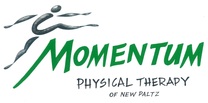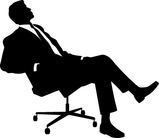 Sitting. It didn't take long before I remembered why I don't like sitting for prolonged periods of time. It is only recently that I have spent more time parked on my posterior between marketing, blogging, (I am currently standing for this one), and reviewing new research along with many other administrative items as owner of my practice. Prior to my leap as a business owner, I was on my feet and moving more during the day as a staff physical therapist in several different clinics. Sitting was something to be cherished when I had the chance. Now under normal circumstances when you are sitting for a while, that soreness sensation, generally in your lower back/sacroiliac region, is the brain and body's gentle way of telling you to MOVE! ANYWHERE! JUST MOVE! It's quite an ingenious alarm system because it works really well....as long as you listen to it. Unfortunately I failed to listen to that initial alarm system recently and that soreness turned into a more constant and very annoying pain to the point where any static position was uncomfortable. It was even a bit challenging to fall asleep and my sleep is not something to be messed with. However, the solution was still an easy one....all I had to do was start moving more. Walking, running, (even a 10 mile trail race), and changing positions all felt great so it is no surprise that my constant pain has decreased almost back to its baseline of normal soreness if I sit for too long. 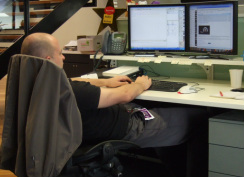 With this experience in mind, I wanted to share some issues related to sitting beginning with a basic understanding of the biomechanics involved and soft tissue considerations. There are different classifications of sitting but for the purpose of this discussion, I will focus on the very technical version that we all succumb to at some point during the day with or without knowing it: the slumped sitting position. 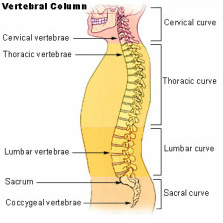 Before going any further, it is important to have a reference point, which would be standing in this case. In stance, the spine is naturally curved when looking at it from the side. More specifically, the lumbar spine, roughly the bottom third of the spine, has a lordotic curve which changes when we sit. Using the L1 vertebrae to the top of the sacrum, Lord et al measured the average decrease in lumbar lordosis angle from standing to an upright sitting position, (90 degree angle at the hips and knees). It was 49 degrees in stance and decreased to 34 degrees in sitting. (1) When the body gets lazy, gives in to gravity and slumps, this change is even more dramatic further decreasing the lordosis and sometimes eliminating it altogether. This by itself is not a cause for concern as it happens normally with many activities like putting your socks on or bending over to tie your shoes. 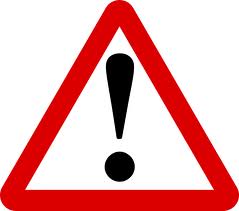 Something else also happens as a result of this position: stretching of posterior structures and tissues of the lumbosacral region. These can include muscles, tendons, ligaments, fascia, etc. In order to accommodate the decrease in lordosis, tissues must lengthen and stretch compared to their length in stance, which is a more neutral position for the spine and pelvis. It should be noted that this by itself is also not a cause for concern because tissues are stretched all of the time throughout the body as we move during the day. Time, on the other hand, is the enemy. When tissues are stretched, they trigger mechanoreceptors which are responding to the mechanical deformation of being lengthened. Initially the messages sent from the mechanoreceptors to the brain are not enough to trigger any type of soreness or pain response but the longer the time being stretched, slumped sitting in this case, the more frequent and "louder" those messages become. If it is long enough without a change, the brain processes the increasing messages and begins to perceive this as a potentially "dangerous" or "threatening" situation, and the output is sensations of soreness first followed by pain. This is the ingenious alarm system mentioned above as the expectation is that you will move so those tissues are not being stretched, (or not in "danger"), anymore allowing the mechanoreceptors, (and your brain), to chill out. This can obviously be overridden, as I did for too long and over several days, since most of the time you know that you are not actually in any danger, just uncomfortable. As I described above, any kind of movement, especially if you get on your feet for a bit to return the normal lordotic curve to your lumbar spine, usually relieves this type of soreness and discomfort. Unfortunately, many of us are stuck sitting, often slumping, for prolonged periods of time for work or in that super soft sofa you love. So do the easy thing: listen to that alarm system, get up and move a little bit. Your body, (and brain), will thank you for it. Stay tuned for Part II as I discuss some of the metabolic issues associated with prolonged sitting. References: 1. MJ Lord, JM Small, JM Dinsay, RG. Watkins. Lumbar lordosis. Effects of sitting and standing. Spine, 22 (1997), pp. 2571–2574. If you found this post to be helpful, please share!
0 Comments
Leave a Reply. |
Dr. Greg Cecere
Your personal physical therapist, movement educator and knowledge dispenser. Newsletter Sign Up
Enter your name and email to get Momentum PT's Movement Manual delivered straight to your inbox! It's your free monthly newsletter and guide to moving better, feeling better and living better! Archives
April 2017
Categories
All
Disclaimer:
The contents of this blog is meant for educational purposes only. Momentum Physical Therapy of New Paltz and Dr. Greg Cecere are not responsible for any harm or injury that may occur due to any information on this blog as it is by no means a substitute for a thorough evaluation by a medical professional. |
|
Momentum Physical Therapy of New Paltz, PLLC. Copyright © 2013-2024. All Rights Reserved.
Disclaimer: The contents of this site is meant for educational purposes only and utilization of any of the material is a personal choice. Momentum Physical Therapy of New Paltz and Dr. Greg Cecere are not responsible for any harm or injury that may occur due to those choices. This site is by no means a substitute for a thorough evaluation and guidance by a licensed medical professional.
|
 RSS Feed
RSS Feed
